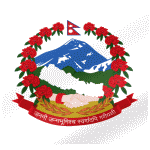The national flag of Nepal is the world's only non-quadrilateral national flag. This unusual Nepalese flag is a simplified combination of two single pennants. The crimson-red rhododendron color represents Nepal's national flower and shows the courage of the Nepalese people, while the blue border represents peace and harmony. The triangular shape of the pennants represents the Himalayas. The White Sun and the Moon represent the hope that Nepal has the same longevity as them. The height-to-width ratio in the flag is 4:3, and the flag was adopted on December 16, 1962.
Its wreath-shaped emblem is surrounded by the country's national flower, the Rhododendron, and includes the summit of Mount Everest, a white map of the country, and male and female hands shaking hands, symbolizing gender equality.
Nepal, officially known as the Federal Democratic Republic of Nepal, is a country in South Asia. Its capital is Kathmandu, and its population is approximately 29,610,000.
| Capital and largest city: | Kathmandu (pop. 975,000) |
| Other major cities: | Pokhara (414,000) Lalitpur (285,000) Bharatpur (280,000) |
| Official languages: | Nepali, English |
| Region: | Southern Asia |
| Ethnic groups: | 16.6% Kshetri 12.2% Brahman-Hill 7.1% Magar 6.6% Tharu 5.8% Tamang 5% Newar 4.8% Kami 4.4% Nepalese Muslims 37.5% Others |
| Religion: | 81.3% Hinduism 9% Buddhism 4.4% Islam 3% Kirant 1.4% Christianity 0.4% Animism 0.5% Irreligion |
| Demonym: | Nepalese |
| Area: | 147,181 km² (56,827 sq mi) |
| Population: | 29,610,000 |
| Currency: | Nepalese rupee |
Tags:
Article




